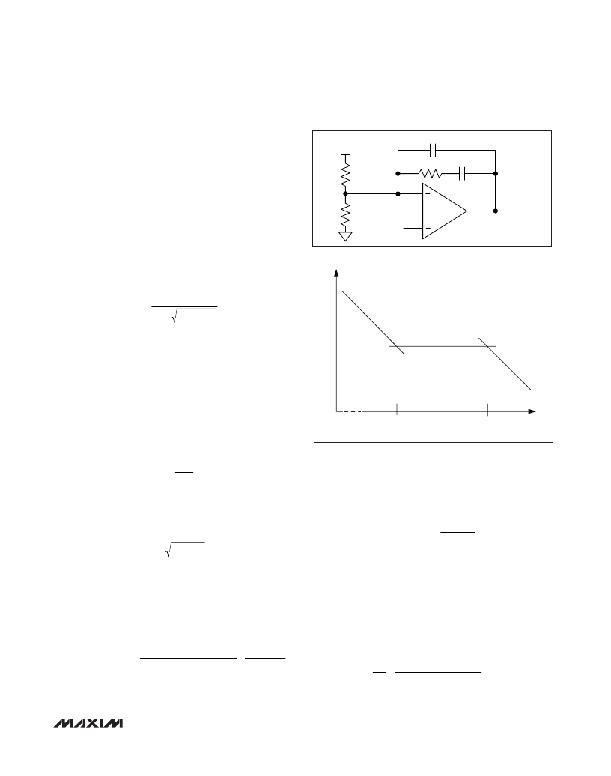- 您现在的位置:买卖IC网 > Sheet目录340 > MAX15022EVKIT+ (Maxim Integrated Products)KIT EVAL FOR MAX15022
�� �
�
 �
�Dual,� 4A/2A,� 4MHz,� Step-Down� DC-DC�
�Regulator� with� Dual� LDO� Controllers�
�Type� II:� Compensation� when� f� CO� >� f� ZERO,� ESR�
�When� the� f� CO� is� greater� than� f� ESR� ,� a� Type� II� compensa-�
�V� OUT_�
�C� CF�
�tion� network� provides� the� necessary� closed-loop� com-�
�pensated� response.� The� Type� II� compensation� network�
�provides� a� midband� compensating� zero� and� a� high-fre-�
�R� 1�
�R� F�
�C� F�
�quency� pole� (see� Figures� 5a� and� 5b).�
�R� F� C� F� provides� the� midband� zero� f� MID,ZERO� ,� and�
�R� F� C� CF� provides� the� high-frequency� pole,� f� HIGH,POLE� .�
�Use� the� following� procedure� to� calculate� the� compen-�
�R� 2�
�FB_�
�V� REF�
�COMP_�
�sation� network� components.�
�Calculate� the� f� ESR� and� LC� double� pole,� f� LC� :�
�Figure� 5a.� Type� II� Compensation� Network�
�f� ESR� =�
�f� LC� ≈�
�1�
�2� π� ×� ESR� ×� C� OUT�
�1�
�2� π� ×� L� ×� C� OUT�
�GAIN�
�(dB)�
�(� )�
�where C� OUT� is the regulator output capacitor and ESR�
�is� the� series� resistance� of� C� OUT� .� See� the� Output-�
�Capacitor� Selection� section� for� more� information� on� cal-�
�culating� C� OUT� and� ESR.�
�Set� the� compensator’s� leading� zero,� f� Z1� ,� at� or� below� the�
�1ST� ASYMPTOTE�
�(� ω� R� 1� C� F� )� -1�
�2ND� ASYMPTOTE�
�R� F� -1�
�R� I�
�3RD� ASYMPTOTE�
�(� ω� R� F� C� CF� )� -1�
�filter’s� resonant� double-pole� frequency� from:�
�f� Z1� ≤� f� LC�
�Set� the� compensator’s� high-frequency� pole,� f� P1� ,� at� or�
�1ST� POLE�
�(AT� ORIGIN)�
�1ST� ZERO�
�(R� F� C� F� )� -1�
�2ND� POLE�
�(R� F� C� CF� )� -1�
�ω� (rad/sec)�
�f� P1� ≤� SW�
�Gain� E/A� =� F�
�Gain� MOD� =� 4(V/V)� �
��
�4� � ESR� x� V� FB�
�R� F� 4� � ESR� x� V� FB�
�2� π� ×� f� CO� OUT_�
�� L� x� V�
�below one-half the switching frequency, f� SW� :�
�f�
�2�
�To� maximize� the� compensator’s� phase� lead,� set� the�
�desired� crossover� frequency,� f� CO� ,� equal� to� the� geomet-�
�ric� mean� of� the� compensator’s� leading� zero,� f� Z1� ,� and�
�high-frequency� pole,� f� P1� ,� as� follows:�
�f� CO� =� f� Z1� � f� P1�
�Select� the� feedback� resistor,� R� F� ,� in� the� range� of� 3.3k� ?�
�to� 30k� ?� .�
�Calculate� the� gain� of� the� modulator� (Gain� MOD� )—com-�
�prised� of� the� regulator’s� PWM,� LC� filter,� feedback� divider,�
�and� associated� circuitry—at� the� desired� crossover� fre-�
�quency,� f� CO� ,� using� the� following� equation:�
�ESR� [m� ?� ]� V� FB� [V]�
�(� 2� π� ×� f� CO� [kHz]� ×� L[� μ� H]� )� V� OUT_� [V]�
�where� V� FB� is� the� 0.6V� (typ)� FB_� input-voltage� set-point,�
�L� is� the� value� of� the� regulator� inductor,� ESR� is� the�
�Figure� 5b.� Type� II� Compensation� Network� Response�
�series� resistance� of� the� output� capacitor,� and� V� OUT_� is�
�the� desired� output� voltage.�
�The� gain� of� the� error� amplifier� (Gain� E/A� )� in� the� midband�
�frequencies� is:�
�R [k� ?� ]�
�R� 1� [k� ?� ]�
�The� total� loop� gain� is� the� product� of� the� modulator� gain�
�and� the� error� amplifier� gain� at� f� CO� and� should� be� set�
�equal� to� 1� as� follows:�
�Gain� MOD� x� Gain� E/A� =� 1�
�So:�
�?� R� F� ?� ?� ?�
�?� ?� ?� ?�
�20� ×� log� 10� ?� R� 1� ?� +� 20� ×� log� 10� ??� 2� π� ×� f� CO� ×� L� x� V� OUT_� ??� =� 0dB�
�� =� 1�
�R� 1�
�______________________________________________________________________________________�
�19�
�发布紧急采购,3分钟左右您将得到回复。
相关PDF资料
MAX15025EATB+T
IC GATE DRVR 2CH 16NS 10TDFN-EP
MAX15053EVKIT+
BOARD EVAL FOR MAX15053
MAX15054AUT+T
IC MOSFET DVR HIGH SIDE SOT-23-6
MAX15070BEUT+T
IC MOSFET DRIVER HNM LL SOT23-6
MAX15103EVKIT#
EVAL KIT MAX15103
MAX1554ETA+T
IC LED DVR WHITE BCKLGT 8TDFN
MAX1570ETE+
IC LED DRVR WHITE BCKLGT 16-TQFN
MAX1573ETE+
IC LED DRVR WHITE BCKLGT 16-TQFN
相关代理商/技术参数
MAX15023ETG/V+
功能描述:DC/DC 开关控制器 4.5-28V Input Dual Out Synch Buck RoHS:否 制造商:Texas Instruments 输入电压:6 V to 100 V 开关频率: 输出电压:1.215 V to 80 V 输出电流:3.5 A 输出端数量:1 最大工作温度:+ 125 C 安装风格: 封装 / 箱体:CPAK
MAX15023ETG/V+T
功能描述:DC/DC 开关控制器 4.5-28V Input Dual Out Synch Buck RoHS:否 制造商:Texas Instruments 输入电压:6 V to 100 V 开关频率: 输出电压:1.215 V to 80 V 输出电流:3.5 A 输出端数量:1 最大工作温度:+ 125 C 安装风格: 封装 / 箱体:CPAK
MAX15023ETG+
功能描述:DC/DC 开关控制器 4.5-28V Input Dual Out Synch Buck RoHS:否 制造商:Texas Instruments 输入电压:6 V to 100 V 开关频率: 输出电压:1.215 V to 80 V 输出电流:3.5 A 输出端数量:1 最大工作温度:+ 125 C 安装风格: 封装 / 箱体:CPAK
MAX15023ETG+
制造商:Maxim Integrated Products 功能描述:BUCK CONTROLL SYNC 4.5~28V 24QFN 制造商:Maxim Integrated Products 功能描述:BUCK CONTROLL, SYNC, 4.5~28V, 24QFN
MAX15023ETG+T
功能描述:DC/DC 开关控制器 4.5-28V Input Dual Out Synch Buck RoHS:否 制造商:Texas Instruments 输入电压:6 V to 100 V 开关频率: 输出电压:1.215 V to 80 V 输出电流:3.5 A 输出端数量:1 最大工作温度:+ 125 C 安装风格: 封装 / 箱体:CPAK
MAX15023EVKIT+
功能描述:电源管理IC开发工具 MAX15023 Eval Kit RoHS:否 制造商:Maxim Integrated 产品:Evaluation Kits 类型:Battery Management 工具用于评估:MAX17710GB 输入电压: 输出电压:1.8 V
MAX15024AATB/V+
制造商:Maxim Integrated Products 功能描述:- Rail/Tube
MAX15024AATB/V+T
功能描述:功率驱动器IC Single Low Side RoHS:否 制造商:Micrel 产品:MOSFET Gate Drivers 类型:Low Cost High or Low Side MOSFET Driver 上升时间: 下降时间: 电源电压-最大:30 V 电源电压-最小:2.75 V 电源电流: 最大功率耗散: 最大工作温度:+ 85 C 安装风格:SMD/SMT 封装 / 箱体:SOIC-8 封装:Tube